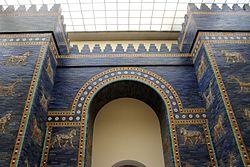| Athura 𐎠𐎰𐎢𐎼𐎠 Aθurā | |||||||||
|---|---|---|---|---|---|---|---|---|---|
| Province of Achaemenid Empire | |||||||||
| 539 BC–330 BC | |||||||||
 Assyria in the Achaemenid Empire, 500 BCE. | |||||||||
| History | |||||||||
• Established | 539 BC | ||||||||
• Disestablished | 330 BC | ||||||||
| |||||||||
| History of Iraq |
|---|
 |
|
|
Athura[1] (Old Persian: 𐎠𐎰𐎢𐎼𐎠 Aθurā Persian pronunciation: [aθuɾaː]), also called Assyria, was a geographical area within the Achaemenid Empire in Upper Mesopotamia from 539 to 330 BC as a military protectorate state. Although sometimes regarded as a satrapy,[2][3] Achaemenid royal inscriptions list it as a dahyu (plural dahyāva), a concept generally interpreted as meaning either a group of people or both a country and its people, without any administrative implication.[4][5][6]
It mostly incorporated the territories of Neo-Assyrian Empire corresponding to what is now northern Iraq in the upper Tigris, the middle and upper Euphrates, parts of modern-day northwestern Iran, modern-day northeastern Syria (Eber-Nari) and part of southeast Anatolia (now Turkey). However, Egypt and the Sinai Peninsula were separate Achaemenid territories.[7][8] The Neo-Assyrian Empire collapsed after a period of violent civil wars, followed by an invasion by a coalition of some of its former subject peoples, the Iranian peoples (Medes, Persians and Scythians), Babylonians and Cimmerians in the late seventh century BC, culminating in the Battle of Nineveh, and Assyria had fallen completely by 609 BC.
Between 609 and 559 BC, former Assyrian territories were divided between the Median Empire to the east and the Neo-Babylonian Empire to the west. Both parts were subsumed into the Achaemenid Empire in 539 BC, and it has been argued that they constituted the satrapies of Media and Aθurā, respectively.[3] In Herodotus' account, the Ninth Tributary District comprised "Babylonia and the rest of Assyria" and excluded Eber-Nari.[9]
Despite a few rebellions, Aθurā functioned as an important part of the Achaemenid Empire and its inhabitants were given the right to govern themselves throughout Achaemenid rule and Old Aramaic was used diplomatically by the Achaemenids.[10]
Known for their combat skills, Assyrian soldiers (along with the Lydians) constituted the main heavy infantry of the Achaemenid military.[11] Due to the major destruction of Assyria during the fall of its empire, some early scholars described the area as an "uninhabited wasteland." Other Assyriologists, however, such as John Curtis and Simo Parpola, have strongly disputed this claim, citing how Assyria would eventually become one of the wealthiest regions among the Achaemenid Empire.[12] This wealth was due to the land's great prosperity for agriculture that the Achaemenids used effectively for almost 200 years.
In contrast to the policy of the Neo-Assyrian Empire, the Achaemenid Persians did not intervene in the internal affairs of their ruling satrapies as long as they continued the flow of tribute and taxes back to Persia.[13]
- ^ Iranian History at a Glance. Alhoda UK. 2005. p. 11. ISBN 978-964-439-005-0.
- ^ Maspéro, Gaston (1900). The Passing of the Empires: 850 B.C. to 330 B.C. Society for Promoting Christian Knowledge. p. 688.
- ^ a b Parpola, Simo (2004). "National and Ethnic Identity in the Neo-Assyrian Empire and Assyrian Identity in Post-Empire Times" (PDF). Journal of Assyrian Academic Studies. 18 (2). JAAS: 18. Archived from the original (PDF) on 2011-07-17. Retrieved 2007-11-13.
With the fall of Nineveh, the Empire was split in two, the western half falling in the hands of a Chaldean dynasty, the eastern one in the hands of Median kings. In 539 BC, both became incorporated in the Achaemenid Empire, the western one as the megasatrapy of Assyria (Aθūra), the eastern one as the satrapy of Media (Māda).
- ^ Cameron, George (1973). "The Persian satrapies and related matters". Journal of Near Eastern Studies. 32: 47–56. doi:10.1086/372220. S2CID 161447675.
- ^ Cook, J.M.: "The rise of the Achaemenids and establishment of their empire", pp. 261–262, in Ilya Gershevitch, Fisher, William Bayne; Gershevitch, I.; Boyle, John Andrew (1968). The Cambridge History of Iran. Cambridge University Press. p. 246. ISBN 978-0-521-20091-2.
- ^ Briant, Pierre (2002): From Cyrus to Alexander: A History of the Persian Empire, pp. 177, 390-391, 909.
- ^ Curtis, John (November 2003). "The Achaemenid Period in Northern Iraq" (PDF). L'Archéologie de l'Empire Achéménide. Paris, France: 3–4.
- ^ "Achaemenid Assyria" at Encyclopædia Iranica
- ^ Briant, Pierre, op. cit. p. 391.
- ^ "Achaemenid Assyria" at Encyclopædia Iranica
- ^ Farrokh, Kaveh; Frye, Richard N. (2009). Shadows in the Desert: Ancient Persia at War. Bloomsbury USA. p. 176. ISBN 978-1-84603-473-2.
- ^ Curtis, John (November 2003). "The Achaemenid Period in Northern Iraq" (PDF). L'Archéologie de l'Empire Achéménide. Paris, France.
- ^ "The Culture And Social Institutions Of Ancient Iran" by Muhammad A. Dandamaev, Vladimir G. Lukonin. Page 104